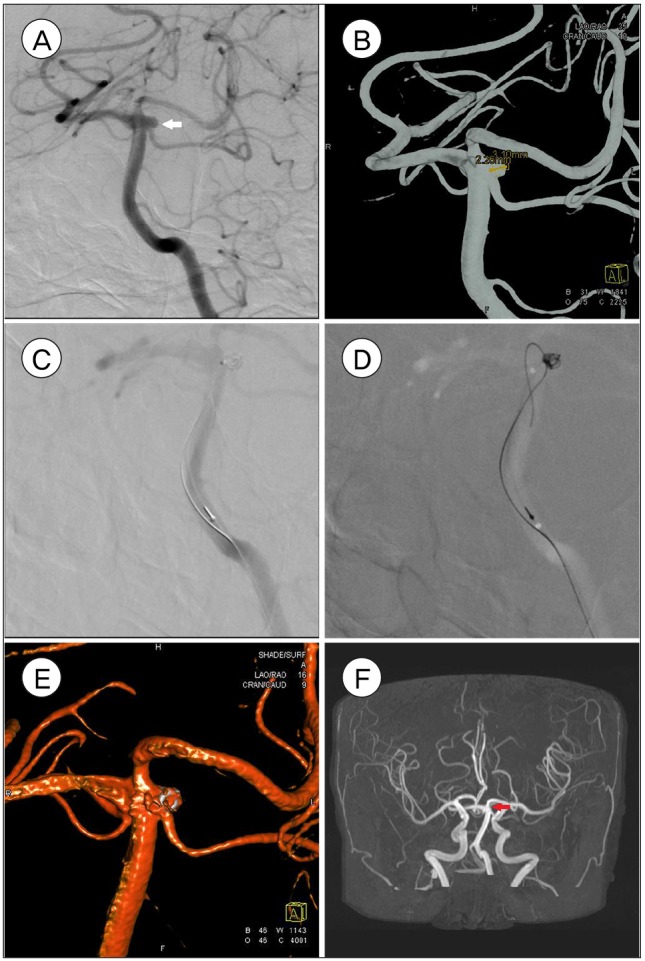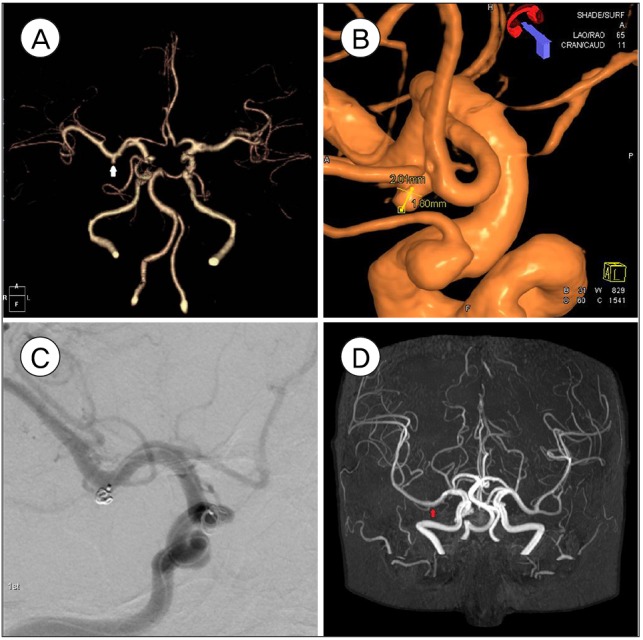J Cerebrovasc Endovasc Neurosurg.
2018 Jun;20(2):106-111. 10.7461/jcen.2018.20.2.106.
Recurrence of Small Cerebral Aneurysms (< 4 mm) Treated Endovascularly Using Target® Nano™ Coils
- Affiliations
-
- 1Department of Neurosurgery, Inje University Haeundae Paik Hospital, Busan, Korea. kusmal@hanmail.net
- 2Department of Neurosurgery, Inje University Busan Paik Hospital, Busan, Korea.
- 3Department of Radiology, Inje University Busan Paik Hospital, Busan, Korea.
- KMID: 2422604
- DOI: http://doi.org/10.7461/jcen.2018.20.2.106
Abstract
OBJECTIVE
In our series, endovascular coiling with Target® Nanoâ„¢ coils (Stryker Neurovascular, Fremont, CA, USA) with diameters of 1 or 1.5 mm exhibited favorable technical feasibility in the treatment of small cerebral aneurysms (< 4 mm). However, little is known about the recurrence of small cerebral aneurysms treated using Target® Nanoâ„¢ coils. We investigated recurrence following the treatment of small cerebral aneurysms using Target® Nanoâ„¢ coils.
MATERIALS AND METHODS
Between January 2012 and November 2013, 143 patients with 148 small cerebral aneurysms (< 4 mm) were included our study. A total of 135 cerebral aneurysms (91.2%) were unruptured; 45 cerebral aneurysms (30.4%) were treated by endovascular coiling using Target® Nanoâ„¢ coils. Follow-up radiological images were obtained for 132 cerebral aneurysms (89.2%) over a range of 3 to 58 months (mean, 34.3 months; standard deviation, 14.2).
RESULTS
In the group treated with Target® Nanoâ„¢ coils, radiological outcomes revealed complete occlusion in 33 (73.3%), residual necks in eight (17.8%), and residual sacs in four (8.9%) cases. Follow-up radiological outcomes revealed complete occlusion in 35 (77.8%) and residual necks in four (8.9%) cases that exhibited stable coil masses. In the group that was not treated with Target® Nanoâ„¢ coils, radiological outcomes revealed complete occlusion in 69 (67%), residual necks in 18 (17.5%), and residual sacs in 16 (15.5%) cases. Follow-up radiological outcomes revealed complete occlusion in 87 (84.5%) and residual necks (5.8%) in six cases that exhibited stable coil masses. No significant differences were observed in the radiological outcomes or follow-up radiological outcomes between the two groups. No recurrences or retreatments occurred in our series.
CONCLUSION
Endovascular treatment using Target® Nanoâ„¢ coils may be a robust treatment option for small cerebral aneurysms (< 4 mm).
Keyword
Figure
Reference
-
1. Bavinzski G, Talazoglu V, Killer M, Richling B, Gruber A, Gross CE, et al. Gross and microscopic histopathological findings in aneurysms of the human brain treated with guglielmi detachable coils. J Neurosurg. 1999; 8. 91(2):284–293. PMID: 10433317.
Article2. Biondi A, Janardhan V, Katz JM, Salvaggio K, Riina HA, Gobin YP. Neuroform stent-assisted coil embolization of wide-neck intracranial aneurysms: strategies in stent deployment and midterm follow-up. Neurosurgery. 2007; 9. 61(3):460–468. PMID: 17881956.3. Brinjikji W, Kallmes DF, Kadirvel R. Mechanisms of healing in coiled intracranial aneurysms: a review of the literature. AJNR Am J Neuroradiol. 2015; 7. 36(7):1216–1222. PMID: 25430855.
Article4. Hayakawa M, Murayama Y, Duckwiler GR, Gobin YP, Guglielmi G, Viñuela F. Natural history of the neck remnant of a cerebral aneurysm treated with the guglielmi detachable coil system. J Neurosurg. 2000; 10. 93(4):561–568. PMID: 11014533.
Article5. Ioannidis I, Lalloo S, Corkill R, Kuker W, Byrne JV. Endovascular treatment of very small intracranial aneurysms. J Neurosurg. 2010; 3. 112(3):551–556. PMID: 19715422.
Article6. Jeong HW, Jin SC. Practical feasibility and packing density of endovascular coiling using target® nano™ coils in small cerebral aneurysms. J Cerebrovasc Endovasc Neurosurg. 2015; 12. 17(4):295–300. PMID: 27064999.
Article7. Kwon OK, Kim SH, Kwon BJ, Kang HS, Kim JH, Oh CW, et al. Endovascular treatment of wide-necked aneurysms by using two microcatheters: techniques and outcomes in 25 patients. AJNR Am J Neuroradiol. 2005; 4. 26(4):894–900. PMID: 15814940.8. Kwon OK, Kim SH, Oh CW, Han MH, Kang HS, Kwon BJ, et al. Embolization of wide-necked aneurysms with using three or more microcatheters. Acta Neurochir (Wien). 2006; 11. 148(11):1139–1145. discussion 1145. PMID: 16990989.
Article9. Molyneux AJ, Kerr RS, Birks J, Ramzi N, Yarnold J, Sneade M, et al. Risk of recurrent subarachnoid haemorrhage, death, or dependence and standardised mortality ratios after clipping or coiling of an intracranial aneurysm in the International Subarachnoid Aneurysm Trial (ISAT): long-term follow-up. Lancet Neurol. 2009; 5. 8(5):427–433. PMID: 19329361.
Article10. Murayama Y, Nien YL, Duckwiler G, Gobin YP, Jahan R, Frazee J, et al. Guglielmi detachable coil embolization of cerebral aneurysms: 11 years' experience. J Neurosurg. 2003; 5. 98(5):959–966. PMID: 12744354.
Article11. Rabinstein AA, Nichols DA. Endovascular coil embolization of cerebral aneurysm remnants after incomplete surgical obliteration. Stroke. 2002; 7. 33(7):1809–1815. PMID: 12105358.
Article12. Raymond J, Guilbert F, Weill A, Georganos SA, Juravsky L, Lambert A, et al. Long-term angiographic recurrences after selective endovascular treatment of aneurysms with detachable coils. Stroke. 2003; 6. 34(6):1398–1403. PMID: 12775880.
Article13. Suzuki S, Kurata A, Ohmomo T, Sagiuchi T, Niki J, Yamada M, et al. Endovascular surgery for very small ruptured intracranial aneurysms. Technical note. J Neurosurg. 2006; 11. 105(5):777–780. PMID: 17121145.14. Weir RU, Marcellus ML, Do HM, Steinberg GK, Marks MP. Aneurysmal subarachnoid hemorrhage in patients with hunt and hess grade 4 or 5: treatment using the guglielmi detachable coil system. AJNR Am J Neuroradiol. 2003; 4. 24(4):585–590. PMID: 12695185.
- Full Text Links
- Actions
-
Cited
- CITED
-
- Close
- Share
- Similar articles
-
- Practical Feasibility and Packing Density of Endovascular Coiling Using Target(R) Nano(TM) Coils in Small Cerebral Aneurysms
- Results of Surgical and Endovascular Treatment of Middle Cerebral Artery Bifurcation Aneurysms: Clinical Research
- Aneurysm Coil Embolization Using a 1.5-Fr Distal Outer Diameter Microcatheter
- The Proportion of Small Aneurysms in the Ruptured Cerebral Aneurysmal Cases : Is the Small Aneurysm Safe From Rupture?
- Intracranial Fusiform Aneurysms: It's Pathogenesis, Clinical Characteristics and Managements



